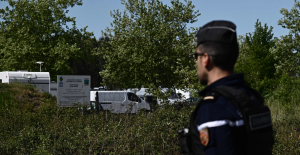One Problem with solar electricity is that demand and production are often in opposite directions: solar fields produce in the summer, the most power, but in the Winter the highest. More solar farms in the mountain regions could provide a remedy, say Swiss researchers.
solar farms in the mountain regions to the need for seasonal electricity better cover than plants in the lowlands. In addition, you need less surface area. According to a study of the Federal Institute of technology Lausanne (EPFL) and the WSL Institute for snow and avalanche research (SLF).
The Team is Not Bald has been calculated for the generation of electricity in different heights and with different inclination of the solar angles of the developed panels in the course of the year. The study will look at the Switzerland, the results could be transferred to similar regions, write the researchers in the "Proceedings" of the US Academy of Sciences ("PNAS").
production
approach A Problem in the use of solar power is that demand and production are often in opposite directions: the solar fields will produce the most electricity in the summer, while the demand for electricity in the Winter is highest. Since it is not sufficiently large capacity for long time storage, complicates this discrepancy, an increase in the solar electricity share of the energy mix. The voting public adopted the energy strategy 2050, but to rely on renewable energy sources instead of nuclear power.
The researchers to Bare therefore investigated a scenario in which half of nuclear-generated electricity through solar power will be replaced. With conventional systems, in the flat country, a solar cell area of about 57 square kilometers would be necessary.
the time for solar farms in the mountain regions above the winter snow line, increasing the productivity for three reasons: first, the atmosphere absorbs at higher altitudes, less solar radiation, the cloud cover in the Winter is in the height of which is less than in the flat country, and the snow reflects in the Winter a lot of sun light.
a Steeper angle needed
the reflected light in the Winter the best use, should be placed the solar panels with an inclination of 65 degrees is significantly steeper than in the Swiss lowlands, where the optimal tilt angle is about 37 degrees.
Such a mountain installations come according to the researchers, with approximately 47 square miles of solar cells surface, about one-sixth less than in the flat country. Due to their increased winter productivity you might need in addition to the seasonally fluctuating electricity better than conventional solar farms in the flat country. The mountain-solar power would reduce the gap between production and demand at least around half.
The ETH Lausanne and the WSL research Institute operating in the ski resort of Parsenn, above Davos, at a test facility. Image: image: EPFL/CRYOS
to avoid snow cover, could be mounted the solar panels in the mountains, completely vertical, stress the researchers. As a result, the winter is declining productivity. Although the necessary solar cell area increases, however, it is still just below the area required in the flat country.
Existing structures use
the Potential environmental impact of mountain-solar farms, the researchers in the study examined. "The direct impact depends on the existing infrastructure," explained Kahl on demand. "If you choose a remote place that has no road access, connection to the electricity grid, the impact is greater than if you installed for example on existing buildings and other structures in a village, a ski resort or water power plants."
The Installation in already developed areas is preferable, and in the Alps already, large parts of the mountain regions, were to be provided with the appropriate infrastructure, said Kahl. This more precise estimate, however, further studies will be needed.
Together with the Zurich University of Applied Sciences (ZHAW) and the electricity company of the Canton of Zurich, the researchers operate a test facility to Kahl currently on the Totalp in Davos, Parsenn ski resort, such as the SLF and EPFL said. So you want to clarify technical and practical issues relating to the production of solar power in the mountains, for example, what is the angle of inclination of the solar panels must have, in order for the snow by itself doesn't slip.
(oli/sda)
Created: 08.01.2019, 09:21 PM

 His body naturally produces alcohol, he is acquitted after a drunk driving conviction
His body naturally produces alcohol, he is acquitted after a drunk driving conviction Who is David Pecker, the first key witness in Donald Trump's trial?
Who is David Pecker, the first key witness in Donald Trump's trial? What does the law on the expulsion of migrants to Rwanda adopted by the British Parliament contain?
What does the law on the expulsion of migrants to Rwanda adopted by the British Parliament contain? The shadow of Chinese espionage hangs over Westminster
The shadow of Chinese espionage hangs over Westminster Colorectal cancer: what to watch out for in those under 50
Colorectal cancer: what to watch out for in those under 50 H5N1 virus: traces detected in pasteurized milk in the United States
H5N1 virus: traces detected in pasteurized milk in the United States What High Blood Pressure Does to Your Body (And Why It Should Be Treated)
What High Blood Pressure Does to Your Body (And Why It Should Be Treated) Vaccination in France has progressed in 2023, rejoices Public Health France
Vaccination in France has progressed in 2023, rejoices Public Health France The right deplores a “dismal agreement” on the end of careers at the SNCF
The right deplores a “dismal agreement” on the end of careers at the SNCF The United States pushes TikTok towards the exit
The United States pushes TikTok towards the exit Air traffic controllers strike: 75% of flights canceled at Orly on Thursday, 65% at Roissy and Marseille
Air traffic controllers strike: 75% of flights canceled at Orly on Thursday, 65% at Roissy and Marseille This is what your pay slip could look like tomorrow according to Bruno Le Maire
This is what your pay slip could look like tomorrow according to Bruno Le Maire Sky Dome 2123, Challengers, Back to Black... Films to watch or avoid this week
Sky Dome 2123, Challengers, Back to Black... Films to watch or avoid this week The standoff between the organizers of Vieilles Charrues and the elected officials of Carhaix threatens the festival
The standoff between the organizers of Vieilles Charrues and the elected officials of Carhaix threatens the festival Strasbourg inaugurates a year of celebrations and debates as World Book Capital
Strasbourg inaugurates a year of celebrations and debates as World Book Capital Kendji Girac is “out of the woods” after his gunshot wound to the chest
Kendji Girac is “out of the woods” after his gunshot wound to the chest Skoda Kodiaq 2024: a 'beast' plug-in hybrid SUV
Skoda Kodiaq 2024: a 'beast' plug-in hybrid SUV Tesla launches a new Model Y with 600 km of autonomy at a "more accessible price"
Tesla launches a new Model Y with 600 km of autonomy at a "more accessible price" The 10 best-selling cars in March 2024 in Spain: sales fall due to Easter
The 10 best-selling cars in March 2024 in Spain: sales fall due to Easter A private jet company buys more than 100 flying cars
A private jet company buys more than 100 flying cars This is how housing prices have changed in Spain in the last decade
This is how housing prices have changed in Spain in the last decade The home mortgage firm drops 10% in January and interest soars to 3.46%
The home mortgage firm drops 10% in January and interest soars to 3.46% The jewel of the Rocío de Nagüeles urbanization: a dream villa in Marbella
The jewel of the Rocío de Nagüeles urbanization: a dream villa in Marbella Rental prices grow by 7.3% in February: where does it go up and where does it go down?
Rental prices grow by 7.3% in February: where does it go up and where does it go down? Europeans: “All those who claim that we don’t need Europe are liars”, criticizes Bayrou
Europeans: “All those who claim that we don’t need Europe are liars”, criticizes Bayrou With the promise of a “real burst of authority”, Gabriel Attal provokes the ire of the opposition
With the promise of a “real burst of authority”, Gabriel Attal provokes the ire of the opposition Europeans: the schedule of debates to follow between now and June 9
Europeans: the schedule of debates to follow between now and June 9 Europeans: “In France, there is a left and there is a right,” assures Bellamy
Europeans: “In France, there is a left and there is a right,” assures Bellamy These French cities that will boycott the World Cup in Qatar
These French cities that will boycott the World Cup in Qatar NBA: the Wolves escape against the Suns, Indiana unfolds and the Clippers defeated
NBA: the Wolves escape against the Suns, Indiana unfolds and the Clippers defeated Real Madrid: what position will Mbappé play? The answer is known
Real Madrid: what position will Mbappé play? The answer is known Cycling: Quintana will appear at the Giro
Cycling: Quintana will appear at the Giro Premier League: “The team has given up”, notes Mauricio Pochettino after Arsenal’s card
Premier League: “The team has given up”, notes Mauricio Pochettino after Arsenal’s card


















